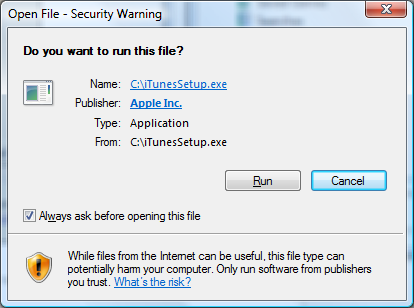Code Signing Compromise Installs Backdoors on Thousands of ASUS Computers - Hashed Out by The SSL Store™ - Hashed Out by The SSL Store™
Code Signing Compromise Installs Backdoors on Thousands of ASUS Computers - Hashed Out by The SSL Store™ - Hashed Out by The SSL Store™ |
| Posted: 01 Apr 2019 12:00 AM PDT Attackers compromised an update server and signed their malware before pushing it to thousands of devices.For most organizations, right after failed audits/compliance penalties, a compromised code signing certificate is the biggest threat posed by digital certificates and their management. That's because code signing serves such a vital function. A verified digital signature is tantamount to instant trust. And when managed and secured responsibly, that facilitates downloads, pushes software updates and helps everything continue to run smoothly throughout all stages of a product's life-cycle. When it's managed poorly – specifically when key security is bungled – it leads to millions of customers having malware pushed on to their computers, which is what happened to Taiwanese tech company ASUS last year. While this is far from the first time this kind of incident has occurred, it does serve as an excellent reminder of the importance of proper key/certificate management, as well as the perils of poor private key security. So, today we're going to talk about that and we'll touch base with a subject matter expert from Sectigo on what could have been done better. Let's hash it out. The Russians are just better at naming cyber attacksBefore we get into the actual technical side of what's happened, I'd once again like to hit a common refrain – something I lament all the time – and that's that the rest of us need to step up our naming conventions if we want to compete with the Russians.  Kaspersky, everyone's favorite Moscow-based cybersecurity firm, and alleged sometimes-partner to the Russian GRU, was the first to report on the ASUS compromise. It has a paper and a presentation slated for a security conference in Singapore next month, and it has dubbed this fiasco, "Operation ShadowHammer."
We're going to get into the specifics of the attack momentarily, but Operation ShadowHammer sounds like the working title of a James Bond film. A couple years ago when Russia attacked Ukraine's power grid, it was dubbed, "Crash Override," which is the pseudonym used by the name character in the wonderfully campy 90s movie, Hackers. Those are names that can put a little sweat on that brow, as opposed to names like EternalBlue, which sounds like an off-brand men's fragrance, or Stuxnet – a potential name for a local public access channel. It's trivial, but let's not pretend like you wouldn't perk up a little more at the mention of "Operation ShadowHammer" than "WannaCry." Explain Operation ShadowHammer to me like I'm fiveLet's start at the top with code signing, and what specifically went wrong here for ASUS – then we can start picking at what it all means. Code signing is the practice of affixing a digital signature to a script or executable – a piece of code – which works as an identifier and a monitor for end users.  Let's say you want to publish a piece of software. You've finished designing it and coding it, now all that's left is you need to distribute it on the internet. But there's a problem. This is the internet – nobody trusts anybody. In a perfect world, end users would have no problem trusting in your good nature and downloading your software. But again, this is definitely NOT a perfect world – this is the internet. That's why we have code signing, which operates on the same principles as any PKI certificate. A trusted certificate vets the organization or individual before issuing them a code signing certificate that can be used to affix a unique digital signature to scripts and executables. When a piece of software is signed, it asserts the publisher's identity and serves as a monitor, acting as a checksum in case the software is tampered with. Here's an example of how an end user's system handles a signed piece of software.  Now, ASUS was using this Code Signing certificate a little bit differently, it was using it to sign software updates. This is another use-case for code signing, by signing updates to software with a trusted key, it safeguards users from downloading malware that's masquerading as a legitimate update. Unless the update is signed by ASUS, it isn't trusted by the ASUS device (unless the user manually decides to accept it – at which point all bets are off). With that cursory explanation of Code Signing out of the way, let's get down to what happened. ASUS had one of its update servers compromised, and residing on said server were at least two of ASUS' signing keys. If an attacker can get access to those keys, it can sign malware and distribute it through ASUS' update channels as a legitimate update. This was a very targeted campaign, as was first reported by Motherboard. The attackers had a list of 600 MAC addresses they were attempting to install backdoors on, all hashed in an attempt to obfuscate their intentions.
What makes this worse is the fact that there were actually two code signing key compromises involved in this incident. The first certificate expired in the middle of 2018. So, the attackers began using another valid one that had apparently been saved on the same compromised server. That shouldn't happen. How could this code signing compromise have been stopped?There are a few ways ASUS could have avoided this situation. The first would have been with an on-demand code signing arrangement, one in which it wasn't charged with physical security. We caught up with Sectigo's Tim Callan, he explained it thusly:
A company the size of ASUS is unlikely to want to relinquish control over its keys and ability to sign unilaterally. It's just too big for that. So while this solution would certainly be helpful for smaller software developers, it likely wouldn't have been an option for ASUS. So, it would come down to key security. Under optimal circumstances signing keys should be stored on external physical hardware tokens, that wasn't the case here:
So, that leaves one last question that's germane to our interest in this compromise: what needs to be done to remediate? Obviously there will need to be a revocation of said certificate, and it will need to be replaced. There will also need to be an informational campaign to help get ahead of the news cycle and inform customers of any potential risks. Kaspersky managed to reverse hash most of the MAC addresses so it's likely ASUS will need to contact those customers directly. Beyond that:
Obviously, there's a lot more going on here than just a compromised signing key, but make no mistake – those keys were the biggest weapon in this attack. The ability to pass off malware as a legitimate piece of software undermines the entire concept of code signing, which is why it's so guarded again. And while a company like ASUS might be too big to offload its signing functions to a third-party company like Sectigo, that doesn't mean it can afford to shirk on key security – or just good security, in general. If anything, the decision to handle things in-house warrants an even more stringent approach to security. This isn't ASUS's first issue, either. And if it doesn't learn from this it's not likely to be its last. As always leave any comments or questions below…  |
| You are subscribed to email updates from "phone encryption iphone,zenfone 2 encryption,how does iphone encryption work" - Google News. To stop receiving these emails, you may unsubscribe now. | Email delivery powered by Google |
| Google, 1600 Amphitheatre Parkway, Mountain View, CA 94043, United States | |
Comments
Post a Comment